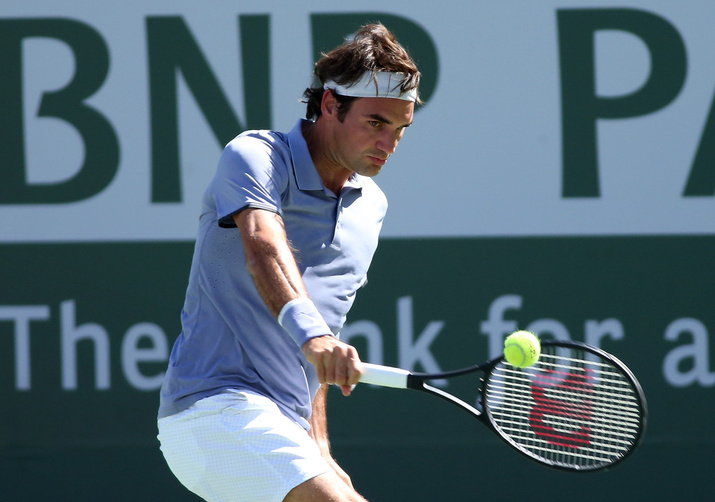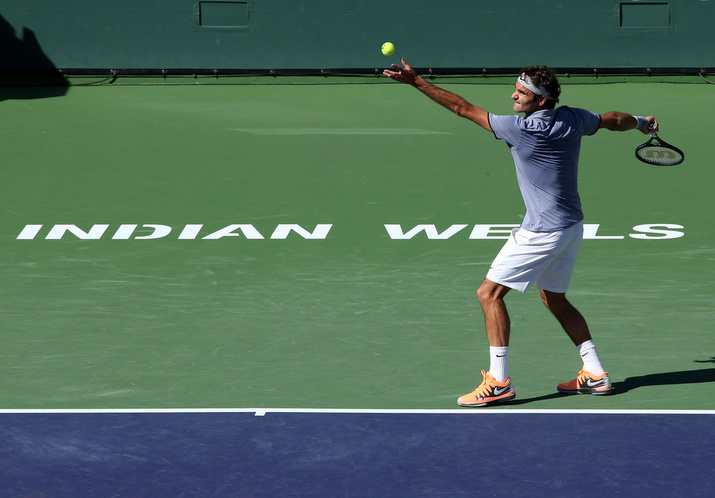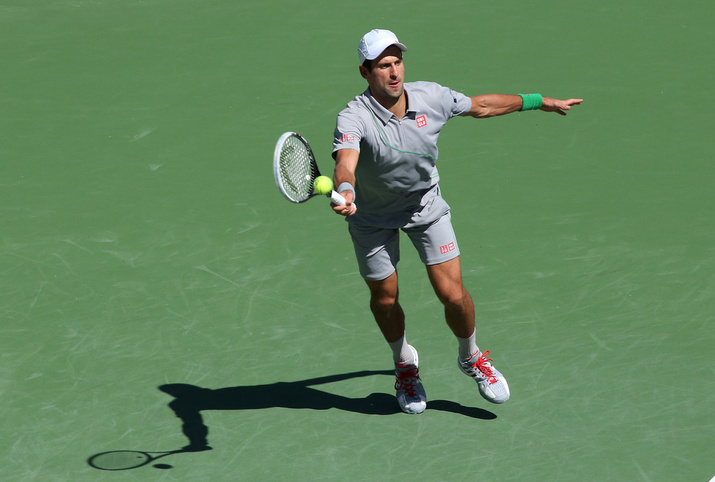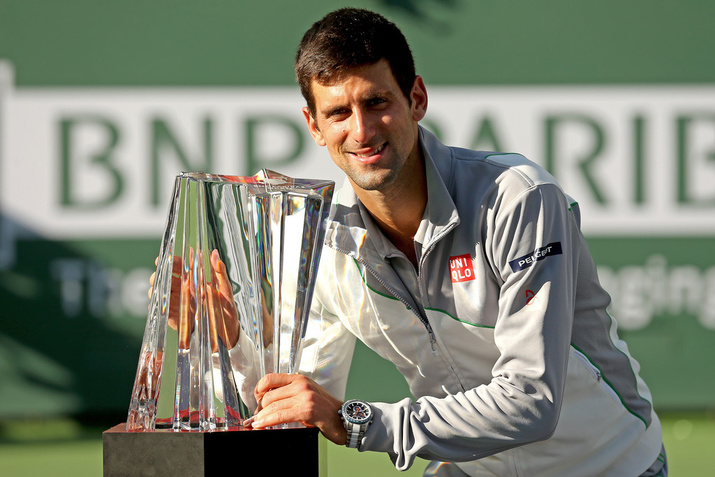Don't miss any stories → Follow Tennis View
FollowDuel in the Desert: Djokovic Edges Federer to Win Indian Wells
After all of the twists, turns, and unexpected turns of the last two weeks, two familiar stars took center stage for the climactic duel in the desert. Roger Federer had won four Indian Wells titles, while Novak Djokovic had won two. The second-ranked player in the world, Djokovic had spent the tournament as the favorite to reach the final from his half. After Rafael Nadal fell in the third round and Andy Murray in the fourth, Federer had become the favorite to meet him there.

Once again, then, two members of the ATP Big Four would vie for the title at an event that they have dominated over the last decade. Only once since 2004 has a man other than Federer, Djokovic, or Nadal triumphed at the BNP Paribas Open, and only once in the last three years has a man outside the Big Four had won the title at any Masters 1000 tournament. The relatively slow hard court in the desert seemed to favor Djokovic’s superior physicality over Federer’s bursts of wizardry and grace.
On the other hand, Federer had impressed much more than Djokovic during this tournament. While the Serb had struggled through three three-set matches, the Swiss star had reached the final without dropping a set. He had defused dangerous dark horse Alexandr Dolgopolov much more efficiently than Djokovic had defeated John Isner on Saturday. Federer also had projected greater confidence on court in matches and off the court in interviews.
Some of this confidence may have come from his recent victory over Djokovic in Dubai, when Federer had rallied after losing the first set. The 17-time major champion also had won their most recent Masters 1000 final on the American hard courts of Cincinnati in 2012. In fact, Federer never had lost a Masters 1000 final in the United States entering Sunday, whereas Djokovic had compiled a strong but not overwhelming record in those situations. When two members of the Big Four collide, however, so little separates them that recent results against other opponents or even the recent history between them do not play a decisive role.
Plenty of intrigue thus surrounded the 33rd meeting between two rivals who had combined for 38 Masters 1000 titles. The stakes arguably stood higher for Djokovic, already off to a slower start than usual this season after failing to win a title in the first two months. He needed to convert this opportunity to assert himself before the season shifts to European clay. One could say the same to a lesser extent of Federer, however, who had not won a title of this significance in 19 months.
At the core of this matchup has been the strength-against-strength battle between the Federer serve and the Djokovic return. Those point-starting shots rank among the best in tennis history for each category. Transcendent serving carried the Swiss to some of his greatest victories over the Serb, such as the 2011 Roland Garros semifinal that remained Djokovic’s only loss at a major that season. Spectacular returning lifted Djokovic to some of his greatest victories over Federer, most memorably a US Open semifinal in which he saved match point with an outrageous return winner.

During this tournament, Federer’s strength had impressed more than Djokovic’s greatest weapon. Whereas Federer had recorded 25 straight service holds and faced only one break point in his last five sets, Djokovic had struggled for long stretches on return and contented himself with a relatively low ratio of break-point conversions.
Both of those talents were on display in the first game. After Djokovic blistered an outright return winner, Federer stymied the Serb with pinpoint first serves. He then profited from a shaky opening service game by Djokovic, which included a double fault and several loose groundstrokes, to claim the early lead. That was an ideal start for a man who hadn’t dropped serve since early in his fourth-round match. Memories of his victory over Djokovic in Dubai last month, when Federer dropped serve only once, probably crept into the minds of both men. Maintaining a high first-serve percentage throughout the first set, the Swiss star never faced a break point as he raced halfway to a fifth Indian Wells title.
The challenge for Federer as he ages, however, has consisted of maintaining his level from start to finish against elite opponents. A fast start too often has preceded a costly lull, and such was the case in the second set of this final. Djokovic found the range on his first serve and groundstrokes as Federer’s own control loosened. Taking Federer to deuce on serve repeatedly early in the set, the Serb pinned his rival behind the baseline with superb depth. Djokovic tends to play his best tennis with his back to the wall, making him one of the most difficult men to finish off.
Despite flat body language, the world No. 2 lost no time in pouncing on the first opportunity that Federer handed him. His first two break points of the match arrived in the eighth game of the second set. Federer would have saved both chances against nearly any opponent, but Djokovic’s sprawling, suffocating brand of defense reaped rewards. A desperate lob found the court and led to a wild error from the Swiss for the decisive break.
Throughout his semifinal victory over John Isner, Djokovic had struggled to consolidate any momentum shifts that he earned. That storyline seemed on the verge of repeating itself when he served for the second set, but he dug out of a 0-30 hole with timely first serves. A frustrated Federer knew that he had opened the door for his opponent to mount a comeback. Djokovic had won nine of their 12 final sets over the previous seven years, so the odds tilted in his favor when he reached that stage in the desert.

The first few games of the third set extended that trend, Federer constantly under pressure as the Serb’s shot-making grew progressively fiercer. Djokovic opened his shoulders to deal devastating blows off both groundstroke wings. While Federer saved a string of early break points with clutch serves and courageous forehands, he could not afford to live so dangerously forever. The strength-against-strength battle of the Swiss serve against the Serbian return swung toward Djokovic when a deep return drew a forehand error for an early break.
But this final had not seen its last plot twist. Federer patiently stayed within range of his opponent, even as Djokovic dominated behind his first serve. A single break remained the slim margin as the moment of truth approached when the world No. 2 would serve for the match. Djokovic had blinked twice in this situation against John Isner a day before, and he blinked again. Despite his mounting ball bounces, he sprayed tentative groundstroke errors when serving for the match. The generally pro-Federer crowd roared in elation when the Swiss star drew level at 5-5.
Relentless aggression from Federer thrust Djokovic’s back to the wall as he served to force a tiebreak. At that stage, the 17-time major champion had won 12 of the last 13 points. Here, though, Djokovic stood tall. He closed out an emphatic service hold with an ace down the center stripe, sending the two rivals to just their second final-set tiebreak in their 33 meetings.
Playing a single seven-point tiebreak often seems like a brutally terse way to decide a Masters 1000 title. A week or more of preparation would come down to who could seize the momentum in a few precious minutes. As he did in their previous final-set tiebreak, seven years ago at the Rogers Cup, Djokovic took that role. He capitalized on Federer’s sagging first serves to draw his opponent into physical rallies where his consistency gave him the edge. Djokovic swept to a 5-1 lead after claiming an early mini-break and ultimately seized the tiebreak by a commanding 7-3 score.

While Federer will have rued a few of his late unforced errors, he voiced pride in how his season has started. After a deflating campaign in 2013, the 17-time major champion has surprised himself with how consistently he has maintained a high level of tennis from week to week. He will head to Miami and the clay season knowing that he still can compete with the best in the game for the biggest titles that it can offer.
Meanwhile, a third title at Indian Wells will have restored much of the Serb’s confidence after a meager start to his 2014 campaign. The first man to defeat Federer in a Masters 1000 final on American soil, he moves into a fifth-place tie with Jimmy Connors and Andre Agassi for Masters Series shields. With the clay season looming, Djokovic needed to secure his first title of the season on North American hard courts to build momentum for yet another charge at a career Grand Slam. Just as importantly, his first victory over a Big Four rival in 2014 bolstered his slightly dented aura after losses this year to Stanislas Wawrinka and Federer.
Perhaps most impressive in Djokovic’s title run at the BNP Paribas Open was his ability to raise his level with each challenge that he encountered. The man who dropped a set to Alejandro Gonzalez and fell far behind early against Marin Cilic scarcely resembled the man who pounded backhands and rifled returns against a 17-time major champion on Sunday. Djokovic also threw each of his last two opponents, John Isner and Federer, lifelines late in matches that could have turned the tide. Recovering to snuff out their renewed hopes and claim the Indian Wells title anyway showed how resilient the Serb has become.
That resilience will be tested when Djokovic seeks to complete the rare North American double at the Sony Open in Miami over the next two weeks. He achieved that feat in 2011 and will deliver an even more emphatic statement than he did on Sunday if he can do it again.










